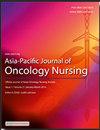Experiences of body image changes in Chinese hematopoietic stem cell transplantation survivors: A qualitative study
IF 2.8
3区 医学
Q1 NURSING
引用次数: 0
Abstract
Objective
This study aimed to explore the experiences of body image changes in hematopoietic stem cell transplantation survivors in China and to depict how those changes affected their perception of self and body.
Methods
A qualitative descriptive approach was applied to provide a straight and comprehensive understanding of experiences in body image changes. Twenty hematopoietic stem cell transplantation survivors who underwent transplantation at a Chinese tertiary hospital were selected through purposeful sampling. Data were collected via semi-structured interviews and analyzed using conventional content analysis. Reporting adhered to the Consolidated Criteria for Reporting Qualitative Research Checklist.
Results
Three themes and 11 subthemes were identified: (1) I am an inferior person (a distinctly weird appearance, an impaired body function, and depending on external resources for survival); (2) I am a person struggling to reconcile with my changed body (struggling to conceal or disclose my changed body, negotiating the impact of my changed body on my work identity, struggling to understand and care for my changed body, and catching up in rumination over my changed body); and (3) I am a brand-new person (having escaped from the gate of hell, enhanced appearance, optimized personality, possessed sublimated emotions).
Conclusions
This qualitative study offers novel insights into the experiences of body image changes in patients with hematological cancers post-hematopoietic stem cell transplantation within the Chinese context. It also presents a journey toward accepting body image changes. Further research is warranted to explore the underlying mechanisms linking body image changes to shifts in self-identity, and the process of body image acceptance.
中国造血干细胞移植幸存者身体形象改变的经验:一项定性研究
目的本研究旨在探讨中国造血干细胞移植幸存者的身体形象变化经历,并描述这些变化如何影响他们对自我和身体的感知。方法采用定性描述的方法,直观、全面地了解身体形象变化的经历。通过有目的的抽样,选择20例在国内三级医院接受造血干细胞移植的幸存者。数据通过半结构化访谈收集,并使用传统的内容分析进行分析。报告遵循报告定性研究核对表的综合标准。结果确定了3个主题和11个子主题:(1)我是一个劣等人(外表明显怪异,身体功能受损,依靠外部资源生存);(2)我是一个挣扎着与我改变了的身体和解的人(挣扎着隐瞒或揭露我改变了的身体,协商我改变了的身体对我的工作身份的影响,挣扎着理解和关心我改变了的身体,追赶着对我改变了的身体的反思);(3)我是一个全新的人(从地狱之门逃了出来,外表增强了,个性优化了,情感升华了)。结论本定性研究为中国造血干细胞移植后血液病患者身体形象改变的经历提供了新的见解。它也呈现了一段接受身体形象改变的旅程。身体形象的改变与自我认同的转变以及身体形象接受的过程之间的潜在机制有待进一步的研究。
本文章由计算机程序翻译,如有差异,请以英文原文为准。
求助全文
约1分钟内获得全文
求助全文
来源期刊

Asia-Pacific Journal of Oncology Nursing
Multiple-
CiteScore
2.80
自引率
11.10%
发文量
136
审稿时长
31 days
 求助内容:
求助内容: 应助结果提醒方式:
应助结果提醒方式:


